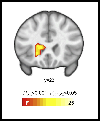Differential responses to infant faces in relation to maternal substance use: An exploratory study
- PMID: 31874448
- PMCID: PMC7060928
- DOI: 10.1016/j.drugalcdep.2019.107805
Differential responses to infant faces in relation to maternal substance use: An exploratory study
Abstract
Background: Maternal substance use and addiction has been associated with negative consequences for parenting and may increase addiction vulnerability in the developing child. Neuroimaging research suggests that substance use may decrease the reward of caring for infants and heighten stress reactivity to affective infant cues.
Methods: Thirty-two substance-using mothers and twenty-two non-substance-using mothers were presented with emotional face and cry stimuli generated from their own and a demographically matched unknown infant during fMRI scanning. Between-group differences in neural activity during task performance were assessed using whole-brain, mixed-effects models corrected for multiple comparisons (voxel-level p < 0.001, pFWE<0.05).
Results: Relative to non-substance-using mothers, substance-using mothers exhibited greater activation when viewing their own infant's face as compared to an unknown infant's face across multiple brain regions, including superior medial frontal, inferior parietal, and middle temporal regions. Substance-using mothers also had a decreased response to sad infant faces in the ventral striatum relative to the non-substance-using mothers. Neural responses to own vs. unknown infant cries did not significantly differ between substance-using and non-substance-using mothers.
Conclusions: Findings suggest overlapping cortical and subcortical brain regions implicated in responding to infant faces, with activation differences related to infant familiarity, emotional expression, and maternal substance use. While prior work has focused on attenuated neural responses to infant cues, greater attention is needed toward understanding the increased reactivity to affective infant cues observed in substance-using mothers.
Keywords: Addiction; Caregiving; Infant cries; Infant faces; Maternal substance use; fMRI.
Copyright © 2019 Elsevier B.V. All rights reserved.
Conflict of interest statement
Conflict of Interest
The authors declare no conflicts of interest with respect to the content of this manuscript. Dr. Potenza has: consulted for and advised Game Day Data, the Addiction Policy Forum, Rivermend Health, Opiant/Lightlake Therapeutics and Jazz Pharmaceuticals; received research support from the Mohegan Sun Casino and the National Center for Responsible Gaming; and consulted for legal and gambling entities on issues related to impulse-control disorders and addictions. The other authors report no disclosures.
Figures


Similar articles
-
Mothers with substance addictions show reduced reward responses when viewing their own infant's face.Hum Brain Mapp. 2017 Nov;38(11):5421-5439. doi: 10.1002/hbm.23731. Epub 2017 Jul 26. Hum Brain Mapp. 2017. PMID: 28746733 Free PMC article.
-
Mothers' neural responses to infant faces are associated with activation of the maternal care system and observed intrusiveness with their own child.Cogn Affect Behav Neurosci. 2018 Aug;18(4):609-621. doi: 10.3758/s13415-018-0592-6. Cogn Affect Behav Neurosci. 2018. PMID: 29651689 Free PMC article.
-
Substance use and mothers' neural responses to infant cues.Infant Ment Health J. 2020 Mar;41(2):264-277. doi: 10.1002/imhj.21835. Epub 2020 Feb 14. Infant Ment Health J. 2020. PMID: 32057121 Free PMC article.
-
The maternal brain: Neural responses to infants in mothers with and without mood disorder.Neurosci Biobehav Rev. 2019 Dec;107:196-207. doi: 10.1016/j.neubiorev.2019.09.011. Epub 2019 Sep 10. Neurosci Biobehav Rev. 2019. PMID: 31518637 Review.
-
The neural basis of responsive caregiving behaviour: Investigating temporal dynamics within the parental brain.Behav Brain Res. 2017 May 15;325(Pt B):105-116. doi: 10.1016/j.bbr.2016.09.012. Epub 2016 Sep 6. Behav Brain Res. 2017. PMID: 27613229 Review.
Cited by
-
Exploring resting frontal EEG and reflective functioning in maternal substance use.Infant Ment Health J. 2022 Jul;43(4):519-532. doi: 10.1002/imhj.21991. Epub 2022 Jun 14. Infant Ment Health J. 2022. PMID: 35699268 Free PMC article.
-
The Value of Mechanistic Experiments to Target the Shared Neural Circuitry of Parenting and Addiction: The Potential for Video Feedback Interventions.Front Psychol. 2021 Oct 4;12:703948. doi: 10.3389/fpsyg.2021.703948. eCollection 2021. Front Psychol. 2021. PMID: 34671289 Free PMC article.
-
Mothering from the Inside Out: Addressing the Intersection of Addiction, Adversity, and Attachment with Evidence-Based Parenting Intervention.Curr Addict Rep. 2021;8(4):605-615. doi: 10.1007/s40429-021-00389-1. Epub 2021 Jul 15. Curr Addict Rep. 2021. PMID: 34306964 Free PMC article. Review.
-
Cannabis use during pregnancy and hemodynamic responses to infant cues in pregnancy: an exploratory study.Front Psychiatry. 2023 Sep 6;14:1180947. doi: 10.3389/fpsyt.2023.1180947. eCollection 2023. Front Psychiatry. 2023. PMID: 37743996 Free PMC article.
-
Maternal alcohol dependence symptoms, maternal insensitivity to children's distress, and young children's blunted emotional reactivity.Dev Psychopathol. 2025 May;37(2):555-577. doi: 10.1017/S0954579424000324. Epub 2024 Mar 1. Dev Psychopathol. 2025. PMID: 38426705
References
-
- Ashburner J, Barnes G, Chen C, Daunizeau J, Flandin G, Friston K, Kiebel S, Kilner J, Litvak V, Moran R, 2014. SPM12 manual Wellcome Trust Centre for Neuroimaging, London, UK.
-
- Feldman R, 2015. The adaptive human parental brain: implications for children’s social development. TINS, 38, 387–399. - PubMed

